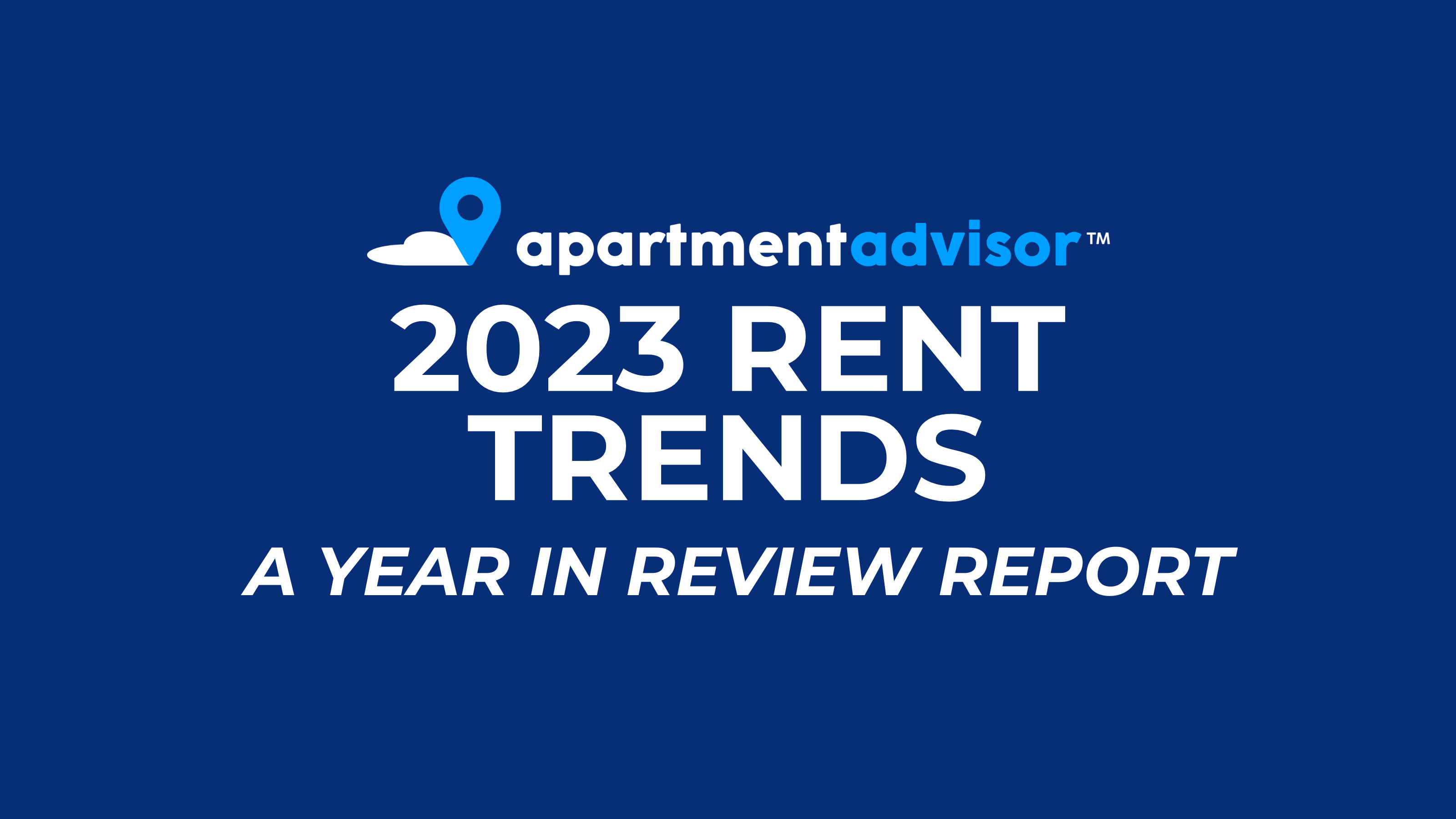
REPORT: 2023 Rent Trends — A Year in Review

By Lena Han
Jan 09, 2024
We analyzed our rental data from the last year to identify key national and regional rent trends across 100 major cities in the US.
Overview
- While both income and prices of other consumer goods have increased throughout 2023, national rent prices of one-bedroom apartments have decreased from June onwards.
- Rent dropped the most in the Mountain West and Southwest regions of the US, correlating with greater increases in housing supply.
- Some of the most expensive cities faced opposite rental market trends: median rent in San Jose, CA dropped drastically, while rent in New York City, NY and Chicago, IL jumped up.
- Three and four-bedroom apartments didn’t see the same price declines that smaller apartments did.
The National Picture: Rent decreased through the second half of 2023.
Much of the 2023 rental market can be read as a reset from the 2022’s post-pandemic jump in rental prices. In 2022, the median rental price began to jump up in April, peaked in July, and remained high throughout the rest of the year. These high rental prices were sustained through the first half of 2023. The national median rent for a one-bedroom apartment in January 2023 was $1,448, 6.9% higher than in January 2022. However, beginning in July 2023, prices began to dip below 2022 levels, steadily decreasing throughout the rest of the year. Overall, median rent at the end of 2023 settled 4.8% lower than median rent at the beginning of the year.
Put in the national economic context, the rent increases in 2022 reflected a broader spike in inflation that summer. Supply-chain issues from the pandemic, the Russian invasion of Ukraine, and the end of pandemic-era rent deals resulted in broad price increases for housing and other goods.
Inflation is measured by comparing the prices of standard goods from year to year in a Consumer Price Index, including everything from food and clothing costs to housing and energy costs. The June 2022 Consumer Price Index was 9.1% higher than the previous year, representing a four-decade record in inflation. Since then, the growth in prices has slowed, but goods have continued getting more expensive throughout 2023. For instance, the price of food was 2.9% more expensive in November 2023 than November 2022.
While other prices continue to grow, rent has actually decreased. Rent costs are now 4.7% lower compared to the end of 2022. The national rent median was still more expensive in the first half of 2023 than the first half of 2022, but the second half of 2023 saw rent declines below 2022 levels.
This decrease in rent prices also contrasts with mortgage rates for homeowners. Listing prices for buying a home are 23% higher than they were two years ago and on par with prices last year. The endurance of inflated housing prices are likely due to the “lock-in effect” where homeowners see their property as an investment and are unwilling to sell for a cost lower than the cost they paid for buying the home. When property values dip, owners are more likely to pull their homes off the market than to sell for lower prices. This effect is reflected in the amount of homes listed for sale; there were 26% fewer homes listed for sale in June 2023 than in June 2022. Consequently, this leaves potential first time homebuyers in the rental market, fighting for a limited number of apartments in already densely populated cities like Boston, MA (where median rent hovered around $3,000 a month for a one-bedroom apartment throughout 2023).
In contrast, landlords have no choice but to adjust rents to the current housing market demand and the prices that renters are willing to pay. Rental listings peaked in April 2023, and landlords may have been forced to reduce rents as they tried to get leases signed.
The According to the Bureau of Labor Statistics, the median annual earnings of full-time workers in the US during the first three months of 2023 was $57,200. Nationally, a one-bedroom apartment cost 30.4% of that figure. In the last three months of 2023, rent prices dropped and incomes rose slightly to $58,136. As a result, rent dropped to 28.6% of earnings.
Overall, the decrease in rent demonstrates that it is currently a comparatively good time to rent for most Americans. While rents are higher than two years ago, they have cooled off more than the prices of other goods and have not kept up with incomes. And compared to buying, sustained home prices and high interest rates tip the scales in favor of renting.
Regional trends: The Mountain West and Southwest regions had the greatest rent declines over the year, while the Midwest and Northeast had the smallest rent declines throughout 2023.
Rent costs are incredibly region specific. The mix of existing apartment buildings, the cost and regulations associated with building new homes, and the demographics of renters look very different across the country.
In 2023, (broadly including states in the western half of the US not bordering the Pacific Ocean) . Median rent for a one-bedroom apartment dropped 9.7% from January to December in Mountain West states, and 8.5% in Southwest states.
One potential explanation for the greater rent drops could be that these regions are building new housing at the fastest rates. Both regions had over 600 new residential buildings authorized per 100,000 people in 2023. Construction of new buildings may be fastest because of the abundant space and continued migration of new residents into states across the Southwest and Mountain West.
Meanwhile, median rent in the Midwest and Northwest has dropped less than 1% over the year. These two regions had the fewest new housing permits issued per capita, and the big cities in the region continue to drive economic growth and new residents, resulting in surplus demand driving up housing prices. Four cities in these two region had rent increases of over 10% during that time: Fargo, ND, Newark, NJ, Grand Rapids, MI, and New York City. Additionally, Maine was the state with the greatest year-over-year increases in rent in December 2023, at 38.1%.
Big City Trends: While most of the biggest cities had rental trends that matched the national average, Chicago, New York City, and San Jose bucked the trend.
With higher incomes and more competition in the rental market, bigger cities in the US have more expensive apartments than the rest of the country. Across the 10 cities with over a million residents, the median one-bedroom apartment cost an average of $1,917 in December 2023. The national median figure was 28% lower, at $1,379.
While all of these cities have median rents above the national average, their rental markets exhibited different patterns from each other. Seven of the 10 cities had similar trends to the national average, with rents increasing slightly over the beginning of the year before falling to around 5% below January rents by the end of the year. However, three cities bucked the trend.
San Jose had a much steeper drop in median rents than the national average, finishing the year with rents 13.15% lower than the beginning of the year. While rents are still significantly more expensive than the national average ($2,173 for a one-bedroom apartment), the drop is perhaps fueled by remote work policies in the tech industry. According to the US Census Bureau, high-tech employment accounted for 24% of employees in San Jose from 2004-2020, almost double the next-highest city. With so many employees in an industry that has largely embraced remote work, people can choose to relocate out of San Jose into cheaper cities, resulting in decreasing rents.
On the other side of the spectrum, Chicago led the pack in rent growth with median one-bedroom rents in December landing 8.6% higher than in January. New York City had similar price growth, with 8.5% higher rents than the beginning of 2023. In these two cities, new rental construction has not kept up with housing demand, and renters have paid the price.
Deep dive: Larger apartments did not experience the same decreases in rent that one-bedroom apartments did.
Just as geography impacts the demographics of renters, apartment size also makes a difference, too. One-bedroom apartments had noticeable declines in rent over the course of the year, but this trend was less true for larger apartments. Nationally, rental properties with three or more bedrooms didn’t experience any slowdown in median rent over the past year.
Building a two or three-bedroom apartment in the US is more difficult than building a one-bedroom or studio apartment. Building codes in the US require multiple exit stairways for all units in most multifamily homes, restricting building designs in smaller lots. Developers are less likely to want to build these larger apartments, and with fewer of these new apartments on the market, prices for existing family-sized apartments will grow. Additionally, the types of households who can afford three-bedroom apartments may have more stable incomes and, as a result, are less likely to move out in response to price increases. Households who are rent-burdened may have no choice but to move if their landlord raises their rent, whereas households who are not can withstand some monthly rent increases. As a result, landlords who lease out multi-bedroom rental units may more easily be able to increase their asking rent.
Receive monthly data drops like this in your inbox with our newsletter.
Subscribe on LinkedInMethodology:
Each month, ApartmentAdvisor publishes a National Rent Report that includes national rent trend data as well as rent price data by state and by city. To create this year in review report, we looked at our rental data from each month of 2023.
ApartmentAdvisor data is based on data from 12+ partners. The set of 100 large cities highlighted in our report is primarily determined by overall population size, however we include some smaller cities with relatively high populations for the home state (e.g. Burlington, VT and Portland, ME) and we exclude some highly populated cities due to their proximity to other major metro areas (eg. Garland, Texas is not included due to its proximity to Dallas).
We take all the unique apartments that were available for any amount of time during a time period, deduplicate them by unit type, and remove unreliable listings. We use a minimum threshold of units for cities to ensure that data is accurate. Luxury bias is removed by focusing on median figures instead of averages.
To learn more about average rent prices and trends in your city, read our National Rent Report.
Top cities
Atlanta Apartments
1,999 apartments starting at $600/month
Austin Apartments
4,949 apartments starting at $600/month
Baltimore Apartments
1,472 apartments starting at $500/month
Boston Apartments
3,499 apartments starting at $940/month
Charlotte Apartments
2,903 apartments starting at $450/month
Chicago Apartments
4,012 apartments starting at $450/month
Dallas Apartments
5,609 apartments starting at $604/month
Fort Worth Apartments
2,193 apartments starting at $600/month
Houston Apartments
4,504 apartments starting at $590/month
Las Vegas Apartments
1,081 apartments starting at $704/month
Los Angeles Apartments
11,535 apartments starting at $625/month
Miami Apartments
544 apartments starting at $1,000/month
Milwaukee Apartments
928 apartments starting at $465/month
New York Apartments
4,118 apartments starting at $488/month
Oakland Apartments
608 apartments starting at $885/month
Orlando Apartments
842 apartments starting at $825/month
Philadelphia Apartments
3,657 apartments starting at $550/month
Phoenix Apartments
4,153 apartments starting at $599/month
Pittsburgh Apartments
1,223 apartments starting at $600/month
Portland Apartments
2,519 apartments starting at $599/month
Raleigh Apartments
1,367 apartments starting at $750/month
San Antonio Apartments
3,925 apartments starting at $525/month
San Diego Apartments
2,960 apartments starting at $650/month
San Francisco Apartments
436 apartments starting at $675/month
San Jose Apartments
405 apartments starting at $1,300/month
Seattle Apartments
3,623 apartments starting at $450/month
Tampa Apartments
1,078 apartments starting at $800/month
Washington DC Apartments
2,878 apartments starting at $745/month


